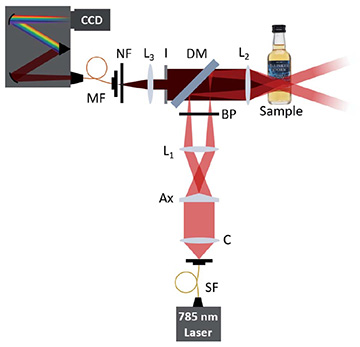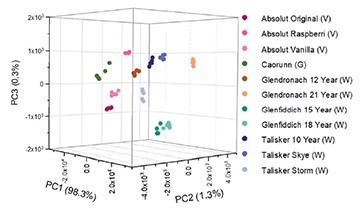![]()
[Image: Adam Wilson, unsplash.com]
For the connoisseur, whisky is serious business; lovingly aged single-malt Scotch varieties sell for hundreds of dollars a bottle—and sometimes a lot more. But without opening and tasting, how can one be sure that what’s in the bottle is the genuine article?
Building on previous work, a team at the University of St. Andrews, Scotland, U.K., offers an answer: use lasers to collect Raman spectra and fluorescence data from a focused point inside the sealed glass bottle, within the whisky itself (Anal. Methods, doi: 10.1039/D0AY01101K). In particular, the team’s approach rests on a clever use of structured light that lets the delicate data from the whisky sneak back out of the bottle, without being swamped by the much stronger Raman signal of the bottle glass.
Probing distilled spirits
The team leader, OSA Fellow Kishan Dholakia, became interested in the possibilities of analyzing whisky with laser light a decade ago, while his group was working on microfluidic chips for analysis of biofluids. “One evening after dinner,” he says, “I was walking through the streets of St. Andrews past a shop, where you see all of these beautiful bottles of whisky on a white background.”
It occurred to him that figuring out a way to analyze whisky with laser light “might be an interesting little small project,” and also a “way to show that photonics can make an impact in everyday lives, in something that a lot of people could relate to.” So he bought a few miniature bottles of whisky, and “things escalated from there.”
The team’s early work on whisky analysis used an optofluidic-chip platform, and focused on Raman and fluorescence spectroscopy. Raman spectroscopy, which generates strong spectroscopic peaks for ethanol, offers a way to validate the whisky’s alcohol content (a minimum of 40% by volume for an authentic Scotch). Fluorescence, meanwhile, opens a possible route for identifying the profile of so-called congeners—the whisky’s complex constellation of trace organic compounds, tannins, “extractives” from the wooden casks used for aging, and other components. These give each whisky its unique fingerprint, but typically constitute 1% or less of the distilled volume.
The glass-bottle conundrum
But what about using these techniques to analyze whisky that’s still in the (unopened) bottle? Here, particularly for Raman, there’s a big hurdle to overcome: the glass bottle itself. “Raman is incredibly sensitive, and very, very powerful,” Dholakia observes. “But of course, everything gives us a Raman signal.” And, in a straight-though setup where the excitation laser is collinear with the collection light, the strong signal from the glass easily overwhelms the less intense signal from the whisky within.
The optical setup used an axicon lens and other elements to project a ring-shaped excitation beam onto the glass bottle exterior, and focus it down to an excitation spot inside the bottle. The Raman signal from the spirits within the bottle then passes back through the light-empty spot on the bottle and to a detector, bypassing the spurious signal from the bottle itself. [Image: H. Fleming et al., Anal. Chem., doi: 10.1039/D0AY01101K (2020); CC BY 3.0] [Enlarge image]
The optical setup proposed by Dholakia, along with postdoctoral researchers Holly Fleming, Mingzhou Chen and Graham Bruce, gets around this problem using structured light and some clever geometry. A Raman excitation beam from a 785-nm Ti:sapphire laser, filtered and delivered by a single-mode fiber, is collimated and then passed through an axicon lens, a specific type of conical optical element. In the near field, the conical axicon forms a Bessel beam—a diffraction-resistant plane-wave pattern that is essentially “a spot with lots of rings around it,” says Dholakia.
Next, the Bessel beam from the axicon is converted, via a thin-lens Fourier transform, into an annular beam—a ring-shaped beam with a hole in the middle. The ring-shaped beam bounces off of a dichroic mirror and through another lens, which focuses the ring down as a hollow cone of light into a focal point well past the clear glass and inside the bottle.
Sneaking through a light-free zone
The upshot is that the excitation light hitting the glass bottle—and, thus, the strong Raman signal from the glass—is limited to a ring-shaped region, with a hollow, light-free zone in the middle. Inside the bottle, meanwhile, the tightly focused light (once again with the characteristics of a pseudo-Bessel beam) is sufficient to excite Raman signals in the whisky itself.
Those signals, in turn, pass out through the center of the hollow light ring on the bottle, proceeding straight through the dichroic mirror and an adjustable iris, which lets the whisky signal sneak through while screening out the strong Raman signal attributable to the ring of light on the glass. A spectrometer and CCD camera then pick up the signal from the whisky for analysis—all without ever uncorking the bottle.
Spirits, olive oil and biological tissue
A principal-component analysis allowed the team to distinguish the data from the eleven spirits tested without opening the bottle that contained them. [Image: H. Fleming et al., Anal. Chem., doi: 10.1039/D0AY01101K (2020); CC BY 3.0] [Enlarge image]
The team tested the system on bottles of 11 different spirits, including seven single-malt Scotch varieties of varying ages, as well as one bottle of gin and three different flavors of a popular vodka. The results suggested that the team’s geometry was highly effective at suppressing the unwanted Raman signal from the glass bottle, and getting at the spirits within. A principal-component analysis (PCA) of the spectra allowed the spirits to be easily distinguished by the in-bottle optical signal. And the team’s work suggested that the axicon setup has some advantages, in simplicity and signal strength, over an alternative geometry called spatially offset Raman spectroscopy (SORS).
While the location of St. Andrews prompted a natural interest in Scotch whisky, Dholakia stresses that the technique could be useful not only for spirits but for other commercial products. He cites olive oil—a huge market notorious for problems of counterfeiting, mislabeling and adulteration—as one possible example.
Biomedical applications could prove another fruitful area, says Dholakia. “One of the biggest challenges is optics—forget the glass—is going to depth” in tissue, he notes. “I hope this geometry may be worth investigating for that.”


